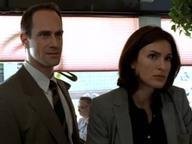Quiz Answer Key and Fun Facts
1. In the season 1 episode "Kiss the Girls and Make Them Die," a young woman named Paige Bartlett is discovered near death, and later dies in the hospital. Greevey and Logan investigate her boyfriend, but he is cleared-- then they discover another boyfriend. When Stone tries to prosecute him, what difficulty does he run up against?
2. In "Manhood," a season 3 episode, a gay officer is left to die when he is shot during a drug bust. He called for back-up several times, and the dispatcher sent patrol cars to help him, but they claim to have gone the wrong way. Actually, one was parked very nearby the whole time. How did the District Attorney find this out?
3. In "Precious," from season 5, a couple first reported their infant daughter kidnapped, but later came under suspicion for murdering her. The police became suspicious when they discovered the couple had lost other children to deaths ruled "Sudden Infant Death Syndrome," and had also attempted to adopt, but had the child removed before the adoption was completed. How many biological children did the couple have?
4. In a season 9 episode called "Flight," a child dies of a rare, and very lethal virus, which it turns out was deliberately injected into his thigh, and therefore, he was murdered. The child was the original target of the killer, but there is an accidental victim as well. Who is it?
5. In the season 10 episode "Mother's Milk," a baby starves to death, because the mother is having trouble breastfeeding, and doesn't give the baby formula. McCoy and Carmichael suspect that deep down, she just didn't want the baby, but she gives another reason for not using formula. What is it?
6. In season 10's "Black, White and Blue," the poor judgment of two police officers results in the death of a white teenager. What do they do that leads to his death?
7. In "Hubris," an episode from season 11, several people are killed in a jewelry store, one of them a child. There is a videotape of the suspect committing part of the crime, but it is ruled inadmissible, because of the way the detectives secured the premises before the search warrant arrived, so the suspect could not enter his apartment and destroy any evidence. What did they do?
8. In the season 12 episode "The Collar," a priest is murdered in the confessional. It turns out that a different priest was actually the target. Why was this priest the target of a murderer?
9. A season 12 episode, "Dazzled," is about the young wife of a middle-aged man, who dies after being pushed off a balcony. What does the titular "dazzle" refer to?
10. In season 13's "American Jihad," an American youth who converted to Islam is arrested for a murder that was an act of religious terrorism. He decides not only to act as Pro Se counsel, but to take the stand. For all his bravado, Dr. Olivet suggests he is terrified of women, and what strategy should be used?
Source: Author
RivkahChaya
This quiz was reviewed by FunTrivia editor
ladymacb29 before going online.
Any errors found in FunTrivia content are routinely corrected through our feedback system.


